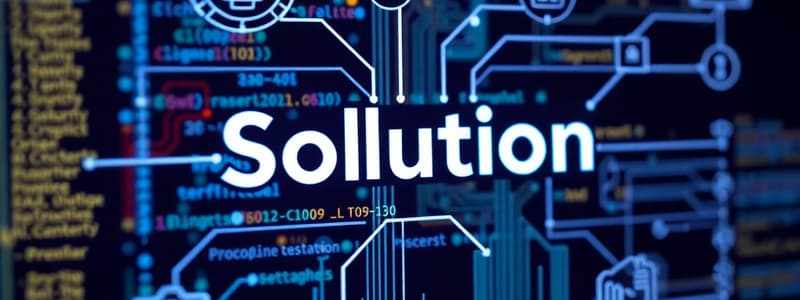Podcast
Questions and Answers
What is the primary purpose of evaluating a solution?
What is the primary purpose of evaluating a solution?
- To increase its complexity
- To ensure it is implemented correctly
- To finalize the documentation
- To determine if it meets the original problem requirements (correct)
A solution is deemed correct only if it is efficient and elegant.
A solution is deemed correct only if it is efficient and elegant.
False (B)
What approach is commonly used to prove a solution's correctness in computer science?
What approach is commonly used to prove a solution's correctness in computer science?
Empirical testing
During evaluation, a solution must be considered _____ until proven otherwise.
During evaluation, a solution must be considered _____ until proven otherwise.
Match the aspects of solution evaluation with their descriptions:
Match the aspects of solution evaluation with their descriptions:
What does the space of an algorithm refer to?
What does the space of an algorithm refer to?
Usability measures how well something can be used by people to achieve their goals.
Usability measures how well something can be used by people to achieve their goals.
What are the four components of usability that can be measured?
What are the four components of usability that can be measured?
An elegant solution maximizes both effectiveness and __________.
An elegant solution maximizes both effectiveness and __________.
Match the following terms with their descriptions:
Match the following terms with their descriptions:
Flashcards
Is the solution correct?
Is the solution correct?
A solution is considered correct if it successfully addresses the original problem it was designed to solve.
How do we know if a solution is correct?
How do we know if a solution is correct?
Determining if a solution is correct involves testing it against specific criteria or requirements. Tests are designed to prove the solution's functionality and identify any errors or bugs.
Is the solution efficient?
Is the solution efficient?
Efficiency in a solution refers to its ability to use resources effectively, minimizing the amount of time and memory it consumes. A program is considered efficient if it achieves its goal with minimal resource usage.
What is 'time' in solution efficiency?
What is 'time' in solution efficiency?
Signup and view all the flashcards
What is 'space' in solution efficiency?
What is 'space' in solution efficiency?
Signup and view all the flashcards
Space Complexity
Space Complexity
Signup and view all the flashcards
Complexity Class
Complexity Class
Signup and view all the flashcards
Elegance in Solutions
Elegance in Solutions
Signup and view all the flashcards
Usability
Usability
Signup and view all the flashcards
Efficiency in Usability
Efficiency in Usability
Signup and view all the flashcards
Study Notes
Topic 8: Evaluating A Solution
- Solution evaluation is crucial after designing, implementing, testing, and debugging a solution.
- Evaluations ensure the quality of the solution.
- Evaluating involves asking basic questions about specific aspects of the solution.
Important Questions About the Solution
- Is it correct?: Does the solution truly solve the problem?
- Is it efficient?: Does the solution use resources reasonably (e.g., time and space)?
- Is it elegant?: Is the solution simple but effective? Is it well-designed?
- Is it usable?: Does the solution provide a satisfactory user experience?
Is It Correct?
-
To be correct, a solution must solve the initial problem, regardless of speed or complexity.
-
Assume programs are incorrect until proven correct through thorough testing and debugging.
-
Correctness is vital in fields like science and law to avoid false positives.
-
Proving correctness can involve mathematical proof, but empirical testing is a more common approach in computer science.
-
Empirical testing involves carrying out a series of tests to validate the solution. Failure in any test indicates an incorrect solution.
-
Testing is an essential part of development. Problem specifications, and tests are prepared in advance.
-
The more tests that a solution passes, the stronger the evidence for its correctness.
-
A test plan example used vending machines
Is It Efficient?
-
Algorithms require resources (time and space) to operate.
-
Efficiency measures how well an algorithm uses these resources, evaluated by considering time and space utilization.
-
Time: The duration of an algorithm's running time (from start to finish) measured as the number of steps.
-
Space: The amount of memory storage an algorithm needs.
-
Algorithm efficiency is assessed by analyzing time and space demands.
-
Different algorithms solve the same problems using varying efficiency. The 'best' algorithm depends on different factors
-
Complexity classes categorize algorithms based on their worst-case performance, indicating how resources would be used in the 'worst' situation for determining how efficiency is measured.
-
Table of common complexity classes provided (from O(1) to O(N!)
Is It Elegant?
-
Elegant solutions are often challenging to create but deliver significant rewards in terms of both simplicity and effectiveness.
-
Elegance considers the depth of understanding of a problem in conjunction with innovative thinking for creating the solution, as simplicity is important
-
While different solutions can solve a problem effectively, their elegance might distinguish them.
-
Elegance isn't limited to software; it applies to disciplines like engineering, science, and mathematics. An elegant solution maximizes both effectiveness and simplicity.
Is It Usable?
- A solution must provide a positive user experience.
- Correctness, efficiency, and elegance are important but usability is paramount.
- Solutions should be easy to learn, use, and forgiving of errors (user-friendly).
- Usability measures how well a solution allows users to achieve their goals.
Usability components
- Learnability: How easy is it for a user to accomplish basic tasks when they first encounter the solution?
- Efficiency: Once versed with the solution, how efficiently can basic tasks be performed?
- Memorability: Can the solution be efficiently re-learned after some time without consistent use?
- Errors: How many errors do users make and how easily can they recover from them?
- Satisfaction: How pleasant or enjoyable is the solution for the user?
Trade-offs
- Solutions are seldom perfect because of factors like human errors or time constraints.
- Optimizing one aspect can negatively impact another.
- Trade-offs are also often inevitable when trying to optimize many aspects of a solution simultaneously.
Studying That Suits You
Use AI to generate personalized quizzes and flashcards to suit your learning preferences.




